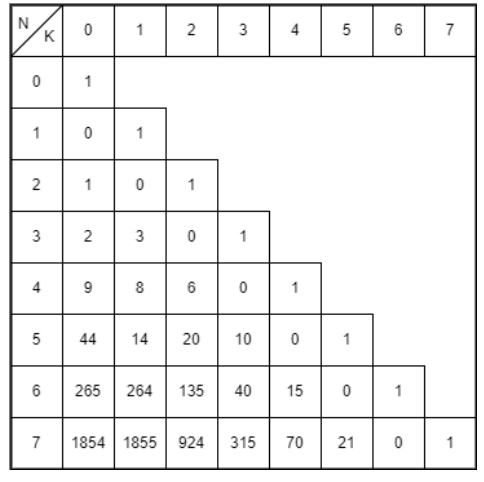
 Data Structure
Data Structure Networking
Networking RDBMS
RDBMS Operating System
Operating System Java
Java MS Excel
MS Excel iOS
iOS HTML
HTML CSS
CSS Android
Android Python
Python C Programming
C Programming C++
C++ C#
C# MongoDB
MongoDB MySQL
MySQL Javascript
Javascript PHP
PHP
- Selected Reading
- UPSC IAS Exams Notes
- Developer's Best Practices
- Questions and Answers
- Effective Resume Writing
- HR Interview Questions
- Computer Glossary
- Who is Who
Rencontres Number (Counting partial derangements) Using C++
Given two integers N and k, we need to count the number of derangements where k points are fixed at their position. Given constraints on k are between 0 and n as the number of fixed points when there are n points cannot be more than n.
int N=4, k=2; res = solve(N, k);

Note that at least conditions don't hold on k. There has to be precisely and strictly k points on their original index. This is a mathematical problem. Not explaining the proof and explanation of mathematics, we as computer science majors can use the results formed by mathematicians. The result is, ?????????(?, ?) = ??? ? ?????????(?? ?, ?)
Let us look at some input/output scenarios
Assume the N points in which there's no fixed points assigned, as the input. The resultant value obtained will be all the combinations of the points ?
Input: N = 4, k = 0 Result: 9
We achieve 9 distinct combinations using any four coordinate points without having any fixed points.
Assume the N points in which all the points are fixed, as the input. The resultant value obtained will be all the combinations of the points ?
Input: N = 4, k = 4 Result: 1
There is only one resultant combination obtained if all points are fixed.
Algorithm
The basic idea of this algorithm is derived from the idea of permutations and combinations of coordinate points on various axes. Hence, it is performed to identify the amount of ways a set of points can be plotted on a graph.
Take number of points and the number of fixed points as an input to the method.
We apply combination formula to find different combinations
If there is no input, the program returns value 1.
If there is no fixed points and one coordinate, the program returns 0.
If there is no fixed point, the program is called recursively to find all the combinations while changing the places of all the coordinates.
If there are fixed points, apply the combinatorial formula
Example
For example, let us consider N=3, k=1; therefore, only 1 point has to be on its original index.
If the given points are {1,3,2}, {3,2,1}, {2,1,3}, following is a C++ program to implement the Recontres number where we count the number of permutations with designated fixed points ?
#include <iostream> using namespace std; int nCr(int n, int r) { if (r==0 || r==n) return 1; return nCr(n-1, r-1) + nCr(n-1, r); } int solve(int N, int k) { if (N==0 && k==0) return 1; if (N==1 && k==0) return 0; if (k==0) return (N-1) * (solve(N-1, 0) + solve(N-2, 0)); return nCr(N, k) * solve(N-k, 0); } int main() { int N=3, k=1; cout << solve(N, k); return 0; }
Output
3
Conclusion
We are using previous results to use DP to store the last values for faster processing. Also, to find the nCr, we can use an optimized approach.

